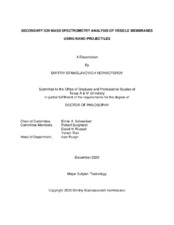| dc.description.abstract | Nanoscale toxins and pollutants such as ultrafine particles and metals from the environment can enter the human body and interact with host membrane proteins disrupting normal metabolism either directly or by causing changes to host membrane organization. It is important to shed light on the mechanism of action of these nanoscale toxins by studying their target proteins and how the host membrane protein-lipid raft complex interactions are modified. To do so there needs to be a technique which can stochastically probe nano-volumes on the membrane surface to characterize protein co-localization on the macroscale. Nano-projectile bombardment secondary ion mass spectrometry (NP-SIMS) is one such technique which uses single gold cluster nano-projectiles as nano-probes to provide information on co-localization of moieties within ~20 nm on the surface by analyzing the related co-emitted species. The purpose of the present work was to develop methodology to apply this unique technique to the study of surface proteins and to test it on vesicle membranes. In order to do so, several challenges were overcome.
The first challenge is that, in practice, upon nano-projectile impact, only molecules and fragments up to ~1500 Da ionize efficiently to be detected thus proteins that are larger in size must be tagged. Several commercially available tagging approaches were tested: lanthanide-chelated polymer scaffold, metal nanoparticle and halide-containing small molecules. Model experiments were performed for each approach with a sub-single layer of antibody conjugated to a representative tag. 142Nd-chelated X8 polymer scaffold and 5 nm PEG-coated gold nanoparticle tags were conjugated to rituximab antibody and covalently attached onto a functionalized silicon wafer. It was found that the tags utilizing the polymer scaffold did not have a strong enough signal to be used with biological samples due to the lanthanide atom density in direct proximity of the antibody being low. The 5 nm gold nanoparticle tag had its signal suppressed because of the PEG cap and antibody layers that inhibited tag-related ion emission from the metal core and thus also did not have the required sensitivity for biological samples. BHHTEGST, eosin and erythrosine, which contained fluorine, bromine and iodine halide tags respectively, could be conjugated directly at the surface of the antibody avoiding the issues of the other two tagging approaches. Thus halide tags were chosen for downstream experiments.
Model samples approximating membrane surfaces which contained covalently attached single layers of Ab conjugated BHHTEGST, eosin or erythrosine tags were prepared and analyzed with NP-SIMS. Based on the yields (ions detected per impact) obtained for fluoride and iodide, the “decision limits” were calculated for BHHTEGST and erythrosine tags respectively. The “decision limit” for erythrosine was between 96 and 236 tagged proteins per µm2 of a membrane. For BHHTEGST, the “decision limit” was between 280 and 685 tagged proteins per µm2 of a membrane. The bromide ions characteristic of eosin were interfered by phosphate-related ions.
A proof-of-concept experiment was performed where the halide-containing molecular tagging approach was applied to detection of podocin on the surface of urine-derived Evs. Briefly, Evs were attached to a functionalized ITO surface via poly-L-lysine (PLL) and labeled with anti-podocin Abs conjugated to erythrosine. Erythrosine contains the iodine tag. Tagged podocin protein was successfully detected. Next, detection of two co-localized proteins on Evs was tested. CD63 and CD81 were tagged on Evs with erythrosine and BHHTEGST respectively. Tagged Evs were then attached as a sub-single layer to a functionalized ITO surface using electrostatic interactions and dehydrated. We were able to successfully detect co-localized tagged CD63 and CD81 in 0.003% of the impacts.
Now that a viable tagging approach was chosen that provides the detection sensitivity required to be able to study at least two tagged proteins on biological surfaces, the next objective was to examine the limits of co-localization of tagged proteins on a single layer model surface similar to a membrane. A model experiment was performed where three halide-containing tags (BHHTEGST, eosin and erythrosine) were conjugated to antibody, mixed equimolarly and covalently attached to a functionalized surface. It was shown that it is possible to detect all three tags in a single projectile impact. Furthermore, degree of co-localization analysis found that the three-tag model surface is inhomogeneous on the scale of emission from a single projectile impact of 20 nm in diameter. The fluctuations in co-localization were attributed to the differences in hydrophobicity and functional groups between the tags. Tags containing BHHTGEST chelated with different lanthanide metals have the same hydrophobicity and chemical properties and were thus used to avoid inhomogeneity at the nanoscale. It was demonstrated for a two-tag (Eu and Sm) model experiment, that tagged Abs attached in a random manner on the surface without density fluctuations detected at the ~20 nm scale.
Future experiments should focus on extending multiplexing capability to the approach as well as incorporating a mapping feature which can determine the location of each impact with sub-micron special resolution. It is possible to use laser post-ionization with BHHTEGST- chelated lanthanide tags in order to enable extensive multiplexing as there are 55 lanthanide isotopes available. These can be ionized with a 193 nm ArF excimer commercially available laser. Additionally, the nano-projectile parameters such as energy, size and momentum can be adjusted to change the nano-volume of emission and detection sensitivity required for a particular analyte. Assuming the above challenges can be overcome, NP-SIMS may then be able to provide unique insights into how toxins affect host membrane protein-lipid raft complexes. | en |


